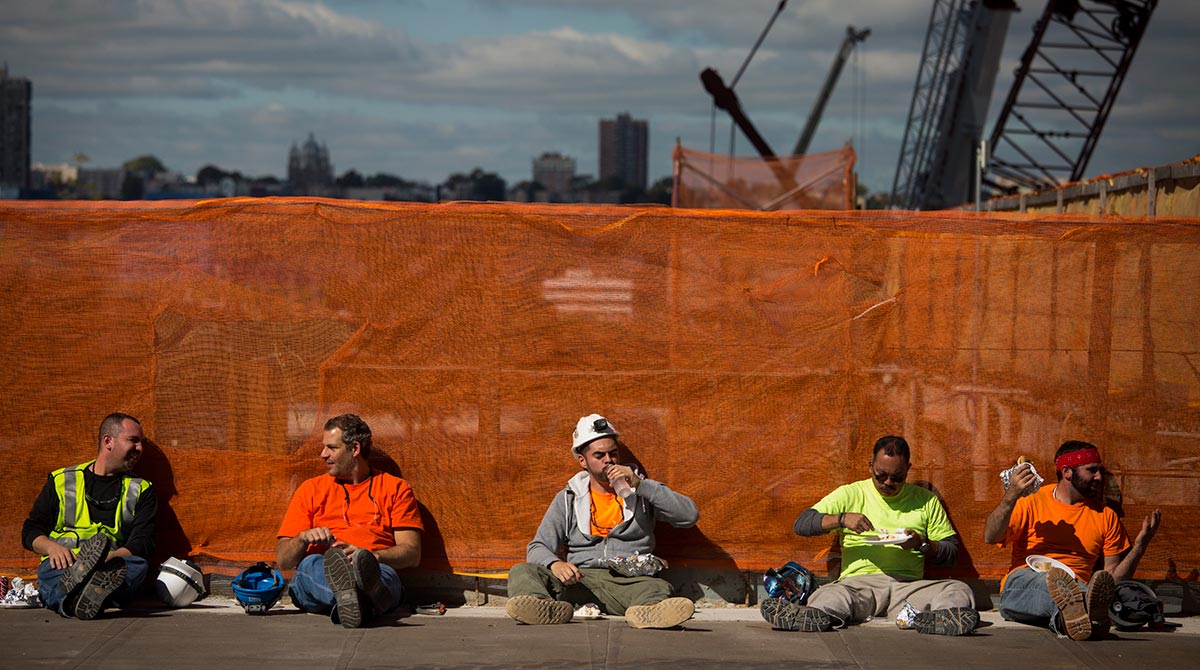Fragile Economy Now Facing a Slowdown in Building Boom

At a quarry in Bridgeport, Texas, where rock is crushed, sorted and cleaned, it’s hard to tell that the nation’s construction boom may be hitting a wall. Workers maneuver front-end loaders to fill a long line of railcars and trucks with up to 25 tons of washed stone each. The destination: one of many construction projects that dot the Dallas-Fort Worth area 70 miles away.
“We’re moving a lot of rock,” said Dean Gatzemeier, who runs quarries in North Texas and Oklahoma for Martin Marietta Materials Inc.
Construction has been one of the few pockets of strength in the U.S. economy — until recently. Construction payrolls have declined since March, and spending in May rose less than 3% from a year earlier, the lowest rate since 2011. Coming after supercharged growth of 10% last year, the question now is whether the sputtering is just a blip or something more lasting that portends a significant drag on the economy.
“It’s a deceleration process after two years of fairly decent growth,” said Robert Murray, chief economist of Dodge Data & Analytics, which gathers data on construction.
Last year’s boom was spurred by housing and office construction. Residential spending alone contributed almost 0.3 percentage point to the U.S. economy’s 2.4% growth rate. New industries, such as e-commerce, also drove construction work, including two Amazon fulfillment centers in California that will be 1 million square feet each.
Yet construction may be a victim of its own success. A torrid pace of apartment building has saturated some markets. Foreign investment, looking for returns, has poured into high-rise condos in Miami and hotels in New York, creating some overcapacity. In one example, Pollack Shores Real Estate Group, a privately held group, put on hold plans to build a 315-unit apartment complex in the Atlanta area as several new buildings cropped up.
Regulators have flagged a heightened risk of lending to commercial real estate, noting that hundreds of banks increased loans to the sector by more than 50% during the past three years.
The slowdown can be seen in construction payrolls. Adjusted for seasonal fluctuations, the number of people working in the field dropped by 22,000 since hitting a post-recession peak in March of about 6.7 million. It was the first time the job count had dropped for two straight months since 2012.
Many in the industry remain buoyant, saying the current slowdown is temporary. Warm winter weather pulled projects forward in the first quarter, which saw construction spending jump 11% , said Ken Simonson, chief economist with the Associated General Contractors of America. That event and heavy flooding in areas such as Texas caused the numbers to stumble in April and May, he said.
Construction spending still has room to grow. As a percentage of the U.S. economy it was 6.4% in the first quarter, below the 50-year average of 8.3%. And while housing starts have rebounded slowly to 1.1 million last year from a 2009 low of 554,000, they remain well under a rate of 1.4 million a year since the 1960s.
Simonson’s group projects that construction spending will rise between 8% and 10% this year as projects to build schools, hospitals and strip malls make up for slower growth of apartment buildings and hotels. Next year, the outlays are expected to increase 6% to 8%, he said, well outpacing the projected growth of the U.S. economy.
Construction companies also are pinning their hopes on public works spending, such as the replacement of New York City’s Kosciuzko Bridge. In December, Congress enacted the first long-term highway bill in a decade, replacing short-term funding patches.
Iowa finally will expand to four lanes a 30-mile stretch of U.S. Highway 20 between Dubuque and Sioux City, said Paul Trombino, director of the state’s Department of Transportation.
“Without knowing that funding will be there, it’s hard to do the big projects,” Trombino said.
Brian Lane, CEO of Comfort Systems USA Inc., hasn’t been able to hire enough qualified employees to accept all the jobs from customers. The Houston-based company installs heating and air-conditioning systems in office buildings, schools and other commercial properties. Welders and pipefitters are particularly difficult to find, and salaries for skilled workers are rising 3% to 6% per year, he said.

